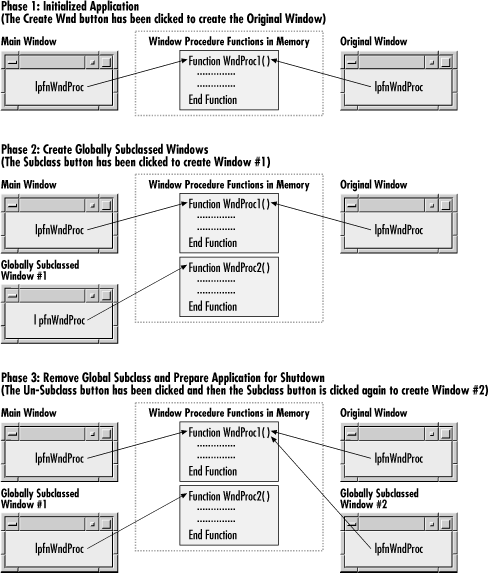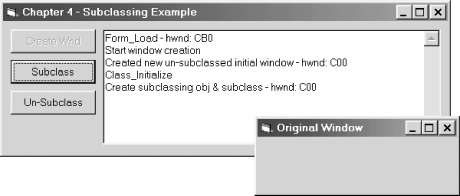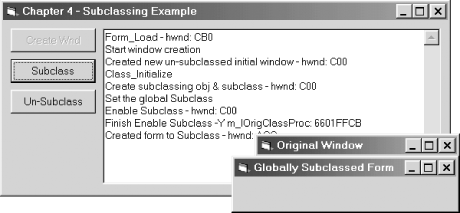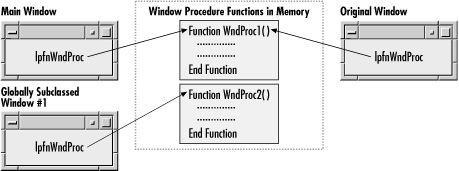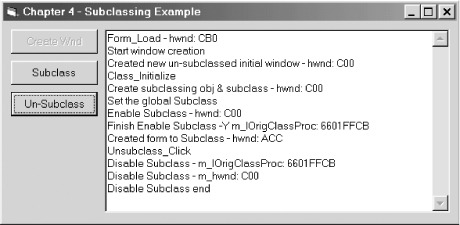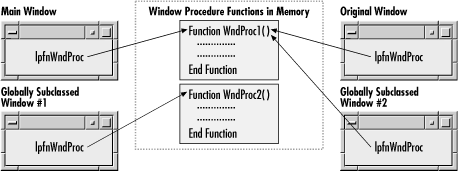Global subclassing revolves around the same principles as instance subclassing. With global subclassing, though, we are going to go one level deeper before performing the subclassing. By this I mean that the modifications to the window procedure function pointer will occur in the class itself, not the individual window created from the class. Only those windows created from the class after the subclassing has occurred will use the new subclassed window procedure. When I mention subclassing in this section, I am referring to global subclassing.
Tip
Instance subclassing affects a specific window and its window procedure. Global subclassing affects every window created from a window class that has had its class window procedure modified.
Unlike instance subclassing, global
subclassing can
capture
the window creation
messages -- and, more specifically, WM_CREATE
and WM_NCCREATE. When a
window
is created, the WM_NCCREATE message is sent first
to the window to finish creating its nonclient area in memory. The
WM_CREATE message is sent next to finish creating
the window’s client area in memory. Note that the window is
still not displayed on the screen at this point. Other messages still
need to be sent to the window to position, size, and paint it on the
desktop.
The reason that instance subclassing cannot capture these messages is that when instance subclassing occurs, the window has already been created. Therefore, the window creation messages have already been processed. Global subclassing, on the other hand, occurs before a window is created. The subclassed window procedure is in place at the point when the window is created. Therefore, all window creation messages are captured.
Tip
Global subclassing allows the window creation messages to be processed. Instance subclassing does not have this ability.
To see how global subclassing differs from instance subclassing, we’ll examine the modifications needed to change the previous instance subclassing example (rolling up the form using the window procedure shown in Example 4-10) to perform global subclassing.
The only real change to the class
module is that you must swap SetWindowLongPtr
for the SetClassLongPtr API function. This
change will provide the
lpfnWndProc member of the class structure
with a pointer to our new window procedure. Along with using this new
API function, there is also a new constant,
GCLP_CLSPROC. This constant tells
SetClassLongPtr to modify the
lpfnWndProc function pointer in the class
structure to point to a new window procedure that we define.
To call SetClassLongPtr, we need to replace the following declarations and constants:
Private Declare Function SetWindowLongPtr Lib "user32" Alias "SetWindowLongA" _ (ByVal hwnd As Long, _ ByVal nIndex As Long, _ ByVal dwNewLong As Long) As Long Private Const GWLP_WNDPROC = -4
with these:
Private Declare Function SetClassLongPtr Lib "user32" Alias "SetClassLongA" _ (ByVal hwnd As Long, ByVal nIndex As Long, ByVal dwNewLong As Long) As Long Private Const GCLP_CLSPROC = (-24)
In addition, you must change the EnableSubclass function in our class module to use:
m_lOrigClassProc = SetClassLongPtr(m_hwnd, GCLP_CLSPROC, _ AddressOf Module1.NewClassProc)
instead of:
m_lOrigClassProc = SetwindowlongPtr(m_hwnd, GWLP_WNDPROC, _ AddressOf Module1.NewWndProc)
The same must be done for the DisableSubclass function. It should use:
SetClassLongPtr m_hwnd, GCLP_CLSPROC, m_lOrigClassProc
instead of:
SetWindowlongPtr m_hwnd, GWLP_WNDPROC, m_lOrigClassProc
Additionally, all references to the
m_lOrigWndProc member variable should be
changed to m_lOrigClassProc.
The SetClassLongPtr API function allows us to modify the structure of a class as long as we have a handle to the window that was created from this class. This means that before we can globally subclass a window class, we must first create a new window from that class. The window handle from this window is used in the first argument of the SetClassLongPtr function.
This example will create the window before globally subclassing the class. Usually, this window is hidden from the user so that the user does not inadvertently close the window and destroy its handle. This handle is also what we need to remove the global subclassing and restore the application to its initial state. Otherwise, the application would crash.
Tip
Global subclassing requires that a window, usually hidden, is created and its hWnd used for global subclassing. This window must remain in memory for the life of the application.
A minor modification is needed in the DisableSubclass function. The modification might seem minor, but it will have a big impact on whether the example will work. Look at the following line in the DisableSubclass function:
m_lOrigClassProc = 0
This line must be removed. If the reason for this is not apparent at
first, let me explain. The object created from the CSubclass class
holds the window handle (m_hwnd) of
the
original window we created before modifying the class. We need to
keep this handle for the lifetime of the application. We also have
the pointer to the original class procedure
(m_lOrigClassProc), which we need to keep
for the lifetime of the application. This is because when we modify a
class through global subclassing and then create new windows from the
modified class, those new windows can exist for the
lifetime of the
application.
When a message is sent to the globally subclassed window, that window will look up its own modified window procedure and call it. In this example, that window procedure would be the NewClassProc function in our BAS module. The problem doesn’t lie here, though. It lies at the end of the window procedure, where we try to call the original class procedure. Remember, the class was subclassed, not the window.
When a window is created from the modified class, the window
procedure it receives from the class is considered to be that
window’s original window procedure. If we had intentionally
removed the global subclass and the code had set the
m_lOrigClassProc variable to
(as it would in instance subclassing),
CallWindowProc would try to dereference a NULL
pointer to get the address of the original window procedure. You
might have thought that just because the global subclassing had been
removed, all windows would suddenly revert to calling their original
window procedure. This is not the case because the
lpfnWndProc member of the window structure
of preexisting windows is not modified by the call to
SetClassLongPtr. Whenever a message is sent to a
globally subclassed window, it still tries to call our
NewClassProc function and, in turn, the original
window procedure (indicated by
m_lOrigClassProc). This is illustrated in
Figure 4-5. This diagram will be discussed in more
detail later in this chapter.
Figure 4-5. The lifetime of the globally subclassed example application where WndProc1 is the window procedure of the unmodified class and WndProc2 is the window procedure of the modified class
These are the only modifications that we will make to this class.
Tip
Do not lose the hWnd and original window procedure contained in the CSubclass class when implementing global subclassing.
The final code for the class is shown in Example 4-11, with revised lines in boldface.
Example 4-11. Modified CSubclass.cls Module for the Global Subclassing Example
#If Win32 Then
Private Declare Function SetWindowLongPtr Lib "user32" Alias "SetWindowLongA" _
(ByVal hwnd As Long, ByVal nIndex As Long, ByVal dwNewLong As Long) As Long
Private Declare Function SetClassLongPtr Lib "user32" Alias "SetClassLongA" _
(ByVal hwnd As Long, ByVal nIndex As Long, ByVal dwNewLong As Long) As Long
m_lOrigClassProc = SetClassLongPtr(m_hwnd, GCLP_WNDPROC, _
AddressOf Module1.NewClassProc)
Private Const GWLP_USERDATA = (-21)
Private Const GWLP_HWNDPARENT = (-8)
Private Const GCLP_MENUNAME = (-8)
Private Const GCLP_HBRBACKGROUND = (-10)
Private Const GCLP_HCURSOR = (-12)
Private Const GCLP_HICONSM = (-34)
Private Const GCLP_HMODULE = (-16)
Private Const GCLP_WNDPROC = (-24)
Private Const DWLP_MSGRESULT = 0
Private Const DWLP_DLGPROC = 4
Private Const DWLP_USER = 8
#ElseIf Not Win16 And Not Win32 Then
Private Declare Function SetWindowLongPtr Lib "user32" Alias "SetWindowLongPtrA" _
(ByVal hwnd As Long, ByVal nIndex As Long, ByVal dwNewLong As Long) As Long
Private Declare Function SetClassLongPtr Lib "user32" Alias "SetClassLongPtrA" _
(ByVal hwnd As Long, ByVal nIndex As Long, ByVal dwNewLong As Long) As Long
Private Const GWLP_HINSTANCE = (-6)
Private Const GWLP_WNDPROC = (-4)
Private Const GWLP_USERDATA = (-21)
Private Const GWLP_HWNDPARENT = (-8)
Private Const GWLP_ID = (-12)
Private Const GCLP_MENUNAME = (-8)
Private Const GCLP_HBRBACKGROUND = (-10)
Private Const GCLP_HCURSOR = (-12)
Private Const GCLP_HICONSM = (-34)
Private Const GCLP_HMODULE = (-16)
Private Const GCLP_WNDPROC = (-24)
Private Const DWLP_MSGRESULT = 0
Private Const DWLP_DLGPROC = 8
Private Const DWLP_USER = 16
#End If
Private m_lOrigClassProc As Long
Private m_hwnd As Long
Public Property Get OrigWndProc( ) As Long
OrigWndProc = m_lOrigClassProc
End Property
Public Property Let hwnd(Handle As Long)
m_hwnd = Handle
End Property
Private Sub Class_Initialize( )
m_lOrigClassProc = 0
m_hwnd = 0
End Sub
Public Function EnableSubclass( ) As Boolean
If m_lOrigClassProc <> 0 Then
'Already subclassed
' Do not allow to subclass a 2nd time
Else
m_lOrigClassProc = SetClassLongPtr(m_hwnd, GCLP_WNDPROC, AddressOf Module1.
NewClassProc)
End If
If m_lOrigClassProc <> 0 Then
EnableSubclass = True
Else
EnableSubclass = False
End If
End Function
Public Function DisableSubclass( ) As Boolean
'Remove global subclass
If m_lOrigClassProc = 0 Then
'Do not remove subclass - none exist
DisableSubclass = False
Else
SetClassLongPtr m_hwnd, GCLP_WNDPROC, m_lOrigClassProc
' DO NOT SET THIS TO ZERO (AS WITH INSTANCE SUBCLASSING)
' OR WE WILL LOSE OUR NEW WINPROC
' m_lOrigClassProc = 0
DisableSubclass = True
End If
End Function
Private Sub Class_Terminate( )
Call DisableSubclass
End SubThe subclassed window procedure in this module will force each globally subclassed window to roll up instead of minimize; this is similar to the last example in Section 4.3 of this chapter.
Some code needs to be added to this subclassed window procedure for it to work on the correct window. This code will iterate through every window belonging to this application and try to find the window handle that matches the one passed in to this function. This will be the window that the subclassed window procedure will operate on. The code modification is as follows:
Dim I As Integer
Dim FocusWindow As Long
FocusWindow = 0
For I = 0 To Forms.Count - 1
If Forms(I).hwnd = hwnd Then
FocusWindow = I
Exit For
End If
Next IGlobal subclassing will allow more than one
window to use the same subclassed window
procedure. This can be very powerful because it allows us to add
functionality to a number of similar windows without having to write
subclassing code for each separate window, as we would with instance
subclassing. The problem is that all the windows that have been
globally subclassed will use the same window procedure
(NewClassProc). So the trick is to determine
which window the message is bound for. This is easier than it looks.
Remember, we are always passed a hWnd window handle in our subclassed
window procedure. We can use the hwnd
argument to set up a loop iterating through each window of the
project to determine which window we need to work with; of course,
this is not the optimal solution. Whenever we need to set the form
height property of this window, for example, we could simply use the
following code:
Forms(FocusWindow).Height = 30
The window procedure then needs to be modified so that we perform our
operations on the window in the
FocusWindow ordinal position in the Forms
collection. Example 4-12 shows the complete window
procedure, with revised lines indicated in boldface.
Example 4-12. The Window Procedure for the Global Subclassing Example
Public Function NewClassProc(ByVal hwnd As Long, ByVal uMsg As Long, _ByVal wParam As Long, ByVal lParam As Long) As LongDim I As IntegerDim FocusWindow As LongNewClassProc = CallWindowProc(CSubClsApp.OrigWndProc, hwnd, uMsg, _wParam, lParam)For I = 0 To Forms.Count - 1If Forms(I).hwnd = hwnd ThenFocusWindow = IExit ForEnd IfNext I'Modify the windows default processing if necessaryIf uMsg = WM_SYSCOMMAND And FocusWindow <> 0 ThenIf wParam = SC_MINIMIZE ThenIf Forms(FocusWindow).WindowState <> vbMaximized Then'Do not process message - instead do our own workForms(FocusWindow).Height = 30End IfNewClassProc = 0ElseNewClassProc = CallWindowProc(CSubClsApp.OrigWndProc, hwnd, uMsg, _wParam, lParam)End If Else 'Pass message to default handlerNewClassProc = CallWindowProc(CSubClsApp.OrigWndProc, hwnd, uMsg, _wParam, lParam)End If End Function
The number of code changes that must be made to the form are substantial. Most notably, the order of events needed to install and uninstall the global subclass must be changed. Also, there is a new button on the form called Create Wnd. This button will create a form; we use this form’s handle to initiate global subclassing. The main form looks the same as the form used in the instance subclassing examples, except for the addition of this new button. In addition to these changes, a brand-new form named frmGlobalSub is added to the project. This new form has no code associated with it, and only its Caption property is changed to read “Globally Subclassed Form”. This new form is used to provide the hWnd that is used in the call to SetClassLongPtr.
Example 4-13 shows the code behind the new button,
which is named cmdCreateWnd. This button-click event first creates a
new form from the frmGlobalSub form that was added to the project. In
a real-life application, this window would be hidden from the user.
Next, an instance of the CSubclass class is
created and initialized with the handle of the window just created.
Finally, this button is disabled. This is to remove the user’s
ability to create another window and a new
CSubclass object.
Example 4-13. The Create Wnd Button’s Click Event Procedure
Private Sub cmdCreateWnd_Click( )
'Create new form
Dim CGSubForm As New frmGlobalSub
CGSubForm.Caption = "Original Window"
CGSubForm.Visible = True
'Create subclassing object
Set CSubClsApp = New CSubclass
CSubClsApp.hwnd = CGSubForm.hwnd
'Do not create a second instance, we will lose the original hwnd
cmdCreateWnd.Enabled = False
End SubThe Click event procedure for
the Subclass button is entirely new; it
is shown in Example 4-14. The code checks to make
sure that a window has been created that can be used to initiate
global subclassing. This is done by making sure that the cmdCreateWnd
button has been disabled. If it has been disabled, the
EnableSubclass public method
in
the CSubclass object is called. This method will
use SetClassLongPtr to modify the
lpfnWndProc member of the class structure.
The last thing this method does is create a new form using the
modified class.
Example 4-14. The cmdSubclass_Click Event Procedure
Private Sub cmdSubclass_Click( )
Dim NewForm As frmGlobalSub
If cmdCreateWnd.Enabled = False Then
Call CSubClsApp.EnableSubclass
Set NewForm = New frmGlobalSub
NewForm.Show
Else
MsgBox "Click on the 'Create Wnd' button to create a window to subclass."
End If
End SubThis button can be clicked multiple times
to create multiple globally
subclassed windows without crashing the application. This is because
the EnableSubclass method will call the
SetClassLongPtr API function only once. After
this method has successfully been called, it knows not to call
SetClassLongPtr a second time. Calling
SetClassLongPtr a second time would cause us to
lose the function pointer
(m_lOrigClassProc) to the original window
procedure in the class.
The Un-Subclass button still calls the
DisableSubclass public method of the
CSubclass class. The only difference is that it
now checks to see if the cmdCreateWnd button has been disabled before
calling the DisableSubclass method. Its single
line of code then appears as follows:
If Not Me.cmdCreateWnd.Enabled Then Call CSubClsApp.DisableSubclass
All the code in the Form_Load event should be removed.
Next, add the following code before the existing code in the Form_QueryUnload event procedure:
'Remove all child windows to prevent a GPF
Dim I As Integer
For I = Forms.Count - 1 To 0 Step -1
If Forms(I).Caption <> "Chapter 4 - Subclassing Example" And _
Forms(I).Caption <> "Original Window" Then
Unload Forms(I)
End If
Next IThis event still destroys the CSubClsApp object,
but certain processing must now happen
before and after the CSubClsApp object
destruction. Before the class is destroyed, all globally subclassed
windows must be unloaded. This code destroys
only
the globally subclassed windows; destroying any other window would
cause our application to crash. Because we know what the window
captions will contain, it is a simple matter of looping through all
the current windows in the application and only unloading the ones
that have been globally subclassed. We do not want to unload the main
form because it is already in the process of being unloaded. Neither
do we want to unload the original window because, as I mentioned
earlier, we would lose our window handle
(m_hwnd) that is needed to release the
global subclassing.
Instead of using the form’s caption to determine if the window has been globally subclassed, you might want to store an array of window handles. You can then loop through this array and unload each window in the array. When using this method, make absolutely certain that you unload every globally subclassed window or your application could crash.
After the class has been destroyed, the original window can be destroyed. The following code, which should be added to the end of the Form_QueryUnload procedure, does just that:
'Remove the original window to clean up
For I = Forms.Count - 1 To 0 Step -1
If Forms(I).Caption = "Original Window" Then
Unload Forms(I)
End If
Next ITip
Unload all globally subclassed forms before destroying the
CSubclass object. Unload the original window that
is used to get the hWnd to initiate global subclassing only after
destroying the CSubclass object.
Example 4-15 shows the complete window procedure, with revised lines indicated in boldface.
Example 4-15. The Modified frmCh4.frm Module for the Global SubclassingExample
Private Sub cmdCreateWnd_Click( )'Create new formDim CGSubForm As New frmGlobalSubCGSubForm.Caption = "Original Window"CGSubForm.Visible = True'Create subclassing objectSet CSubClsApp = New CSubclassCSubClsApp.hwnd = CGSubForm.hwnd'Do not create a second instance, we will lose the original hwndcmdCreateWnd.Enabled = FalseEnd SubPrivate Sub cmdSubclass_Click( )If cmdCreateWnd.Enabled = False ThenCall CSubClsApp.EnableSubclassSet NewForm = New frmGlobalSubNewForm.ShowElseMsgBox "Click on the 'Create Wnd' button to create a window to subclass."End IfEnd Sub Private Sub cmdUnSubclass_Click( )If cmdCreateWnd.Enabled = False ThenCall CSubClsApp.DisableSubclassElseMsgBox "Click on the 'Create Wnd' button to create a window to subclass."End IfEnd Sub Private Sub Form_QueryUnload(Cancel As Integer, UnloadMode As Integer)'Remove all child windows to prevent a GPFDim I As IntegerFor I = Forms.Count - 1 To 0 Step -1If Forms(I).Caption <> "Chapter 4 - Subclassing Example" _And Forms(I).Caption <> "Original Window" ThenUnload Forms(I)End IfNext I'Make sure class is destroyed here Set CSubClsApp = Nothing'Remove the original window to clean upFor I = Forms.Count - 1 To 0 Step -1If Forms(I).Caption = "Original Window" ThenUnload Forms(I)End IfNext IEnd Sub
Quite a few code changes and additions were made to the form module, but global subclassing does operate a bit differently than instance subclassing.
When you run this code, the global subclassing application is easy to use; here are the steps you follow to use this application:
Click the Create Wnd button.
Click the Subclass button. (This button can be clicked multiple times to create globally subclassed windows.)
Closing the application can be done in one of two ways:
Click the Un-Subclass button and then close the application.
Close the application without clicking the Un-Subclass button.
When you click the Create Wnd button, a new window is created with the caption “Original Window”. This window’s handle is needed by SetClassLongPtr to initiate global subclassing. This is also the window that is usually hidden from the user. Now the application has all the information it needs for global subclassing.
When the user clicks the Subclass button, a new window is created and displayed. This window has the caption “Globally Subclassed Form”. Here’s the interesting part. When you click the Minimize button on the title bar of the window with the caption “Original Window”, the window is minimized as it normally would be. When you click the Minimize button for the window with the caption “Globally Subclassed Form”, the form rolls up instead of being minimized. That’s not all. If you click the Subclass button repeatedly, new windows will be displayed with the caption “Globally Subclassed Form”. Each new window will also roll up when the Minimize button is clicked.
Instead of performing instance subclassing on each window separately,
which would be a lot of work, we have altered the base functionality
of every window to suit our needs. Clicking the Un-Subclass button
and closing the application will destroy all the created windows and
restore the original lpfnWndProc function
pointer in the form window class.
Now that you know how to use this example application, let’s take a look at what is going on behind the scenes. Nothing of real interest happens when the application is first started. Clicking the Create Wnd button only sets up the application for global subclassing. At this point, no subclassing of any kind has occurred. The application will be displayed on the screen similar to Figure 4-6.
Nothing much has happened so far. Neither window has been modified, so they each will use their own default window procedure. The state of the application can be seen in Figure 4-7.
The next step is to click the Subclass button. This creates a new window, and the application now appears as in Figure 4-8.
The code for the Subclass button calls the
EnableSubclass public method of the
CSubclass class. The
EnableSubclass method will use
SetClassLongPtr to modify the class that was
used to create the original window (from here on out, when I use the
term “original window” I am referring to the window with
the caption “Original Window”). The class that this
function modifies is ThunderRT6FormDC. The
SetClassLongPtr API function requires a window
handle (m_hwnd) to modify the function
pointer to the class window procedure. This window handle must be
taken from a window created from the class that we want to globally
subclass.
After calling SetClassLongPtr, the class’
lpfnWndProc function pointer to its window
procedure is now pointing to our new subclassed window procedure,
NewClassProc. As with instance subclassing, we
retain the original window procedure in the
m_lOrigClassProc member variable so that
we can restore the class to its original state.
Because the class was globally subclassed after the original window was created, the original window will continue using the pointer to the class’s original window procedure (this is the same pointer that is contained in the m_lOrigClassProc member variable). When the original window was created, the class information used to create this window was copied into the window structure. The pointer to this window’s window procedure is no longer tied to the class’s window procedure. Therefore, it remains unchanged.
The second thing that the Subclass button does is create a new window from the same form object from which the original window was created. This new window uses the function pointer to the window procedure that is now contained in the modified class. Therefore, when you click the Minimize button for the original window, the window is actually minimized the way Windows intended, and when you click the Minimize button of the new window, it rolls up instead of minimizes. Figure 4-9 shows the state of the application at this point.
Each time the Subclass button is clicked, a new window is created. This new window will use the same class that we previously modified. Therefore, each new window will roll up as well.
The next step is to click the Un-Subclass button. The screen should
look something similar to Figure 4-10. The code
behind this button calls the DisableSubclass
public member function of the CSubclass class. The
only action DisableSubclass performs is to call
SetClassLongPtr, which removes the global
subclass. If you observe the functionality of each created window,
you will notice that the way they function has not changed, even
though the global subclass has been removed. This is because only the
class structure has changed; not the window structure of each
existing window. If you minimize the original window, it still works
the way the Windows operating system intended it to work. Each new
window created after the Subclass button was clicked retains the
roll-up functionality.
There is no reason for this application to crash at this point. The
subclassed window procedure NewClassProc is
still available at the same location. Therefore, no function pointers
are pointing to invalid memory locations. We still have the member
variable that contains the original class’s window procedure
(m_lOrigClassProc). That way, when our
subclassed window procedure, NewClassProc, calls
CallWindowProc to pass on the message, a valid
window procedure is found. The modified window class has been changed
back to use its original class window procedure, which is also still
valid.
The interesting thing to do now is click the Subclass button again.
Because the m_lOrigClassProc member
variable still contains the class’s original window procedure,
the code will not allow SetClassLongPtr to be
called a second time. This way we are assured of not losing the
original class’s window procedure. After bypassing the call to
set another global subclass, the code creates a new window. This
window inherits its properties from the restored window class, which
now has its original class window procedure. The newly created window
uses this window procedure as its default. Clicking the Minimize
button of this new window will minimize it the way Windows intended
it to be minimized. This is shown in Figure 4-11.
Figure 4-11. State of the application after clicking the Un-Subclass button (the Globally Subclassed Window #2 is created after removing the global subclass with the SetClassLongPtr API function; notice that it uses the unmodified class’s window procedure as its own)
It is also important to note that if the application is closed before
the global subclass is removed, the CSubclass
class will automatically remove the global subclass when the class is
destroyed. This prevents our application from crashing.
To see how this application works from
the inside, let’s use the Spy++
utility to spy on the global subclassing example. For this purpose,
you should use the application’s compiled EXE, rather than
running it from the development environment. The information that you
see in Spy++ for an application that is running in the development
environment most likely will not be correct because of the way VB
handles the AddressOf operator while running an
application in the IDE. Note, though, that when running this example
on your computer you will not see the memory addresses and handles
that I use here. I am using these values to show you the
relationships between classes and their windows.
First, let’s start up the global subclassing example and then run Spy++. View the application’s windows by selecting the Spy → Windows menu item or by pressing Ctrl-W. Find the line which has the window caption followed by the word ThunderRT6Main (i.e., “Chapter 4 -- Subclassing Example” ThunderRT6Main). I will refer to this window as the main form. At this point, the main window is displayed, and the information we gather from the General and Class tabs of the Windows Properties dialog box is as follows:
Window Caption = "Chapter 4 - Subclassing Example" hWnd = 00190444 Wnd Proc = 6601FFCB Class Name = ThunderRT6FormDC Class Wnd Proc = 6601FFCB
A window has been created and displayed; that is about it. Next, click the Create Wnd button on the main form, then switch to Spy++ and press F5 to refresh the Spy++ display. A new window is displayed with the following attributes:
Window Caption = "Original Window" hWnd = 00460536 Wnd Proc = 6601FFCB Class Name = ThunderRT6FormDC Class Wnd Proc = 6601FFCB
The main window’s attributes remain the same as before you clicked the Create Wnd button. Now everything is in place for us to successfully perform global subclassing. Here comes the interesting part. Click the Subclass button on the main form. Now let’s take a look at the attributes of all three windows:
Window Caption = "Chapter 4 - Subclassing Example" hWnd = 00190444 Wnd Proc = 6601FFCB Class Name = ThunderRT6FormDC Class Wnd Proc = 004050C5 Window Caption = "Original Window" hWnd = 00460536 Wnd Proc = 6601FFCB Class Name = ThunderRT6FormDC Class Wnd Proc = 004050C5 Window Caption = "Globally Subclassed Form" hWnd = 00D5053E Wnd Proc = 004050C5 Class Name = ThunderRT6FormDC Class Wnd Proc = 004050C5
As you might notice, the Class Wnd Proc field changed from
6601FFCB to 004050C5. This
field was changed through the SetClassLongPtr
function. This Class Wnd Proc field is the same for all windows. This
is correct because the class information is stored separately from
the window information. By looking at this information, you can see
that the first two windows that were created remained
unchanged -- they continue to use their old window procedures. The
third window is using the new window procedure (Wnd Proc) from the
ThunderRT6FormDC class. This is because the first
two windows were created using the original class information, while
the third window was created after we modified the class’s
window procedure. If we create more global subclassed windows, their
information is the same as the window with the caption
“Globally Subclassed Form” (except, of course, for the
window handle, which must be unique for all windows).
Now click the Un-Subclass button on the main form. Switch to Spy++, press F5 to refresh its display, and now view each window’s information. The new window information is as follows:
Window Caption = "Chapter 4 - Subclassing Example" hWnd = 00190444 Wnd Proc = 6601FFCB Class Name = ThunderRT6FormDC Class Wnd Proc = 6601FFCB Window Caption = "Original Window" hWnd = 00460536 Wnd Proc = 6601FFCB Class Name = ThunderRT6FormDC Class Wnd Proc = 6601FFCB Window Caption = "Globally Subclassed Form" hWnd = 00D5053E Wnd Proc = 004050C5 Class Name = ThunderRT6FormDC Class Wnd Proc = 6601FFCB
The class’s window procedure has been changed back to its
original value. This value was kept in the
m_lOrigClassProc member variable in the
CSubclass class. Even though the class’s
window procedure is changed back, each window’s window
procedure remains as it was before clicking the Un-Subclass button.
Every window whose Wnd Proc field points to the original window
procedure will act like a normal window. Every window whose Wnd Proc
field points to the new window procedure that we created will use our
modified functionality.
Here is the tricky part, which can bring your application crashing
down around you if you are not careful: because each window’s
window procedure remains the same, subclassed windows will still call
the globally subclassed window procedure,
NewClassProc. The
NewClassProc window procedure still needs to
know the original window procedure to call whenever it receives a
message. If we get rid of the value in the
m_lOrigClassProc member variable, the
application will crash because
m_lOrigClassProc would then point to an
invalid location in memory. So, we need to protect the
m_lOrigClassProc member variable from
being modified in any way.
What happens if the Subclass button is clicked at this point? If we click it, a new window appears with the caption “Globally Subclassed Form”. This form has the following attributes:
Window Caption = "Globally Subclassed Form" hWnd = 3B5E042C Wnd Proc = 6601FFCB Class Name = ThunderRT6FormDC Class Wnd Proc = 6601FFCB
The example code bypasses the call to
SetClassLongPtr and instead creates a window
from the current ThunderRT6FormDC class. This
window will not have the modified window behavior (notice the value
for
the
Wnd
Proc
field).
Get Subclassing and Hooking with Visual Basic now with the O’Reilly learning platform.
O’Reilly members experience books, live events, courses curated by job role, and more from O’Reilly and nearly 200 top publishers.
